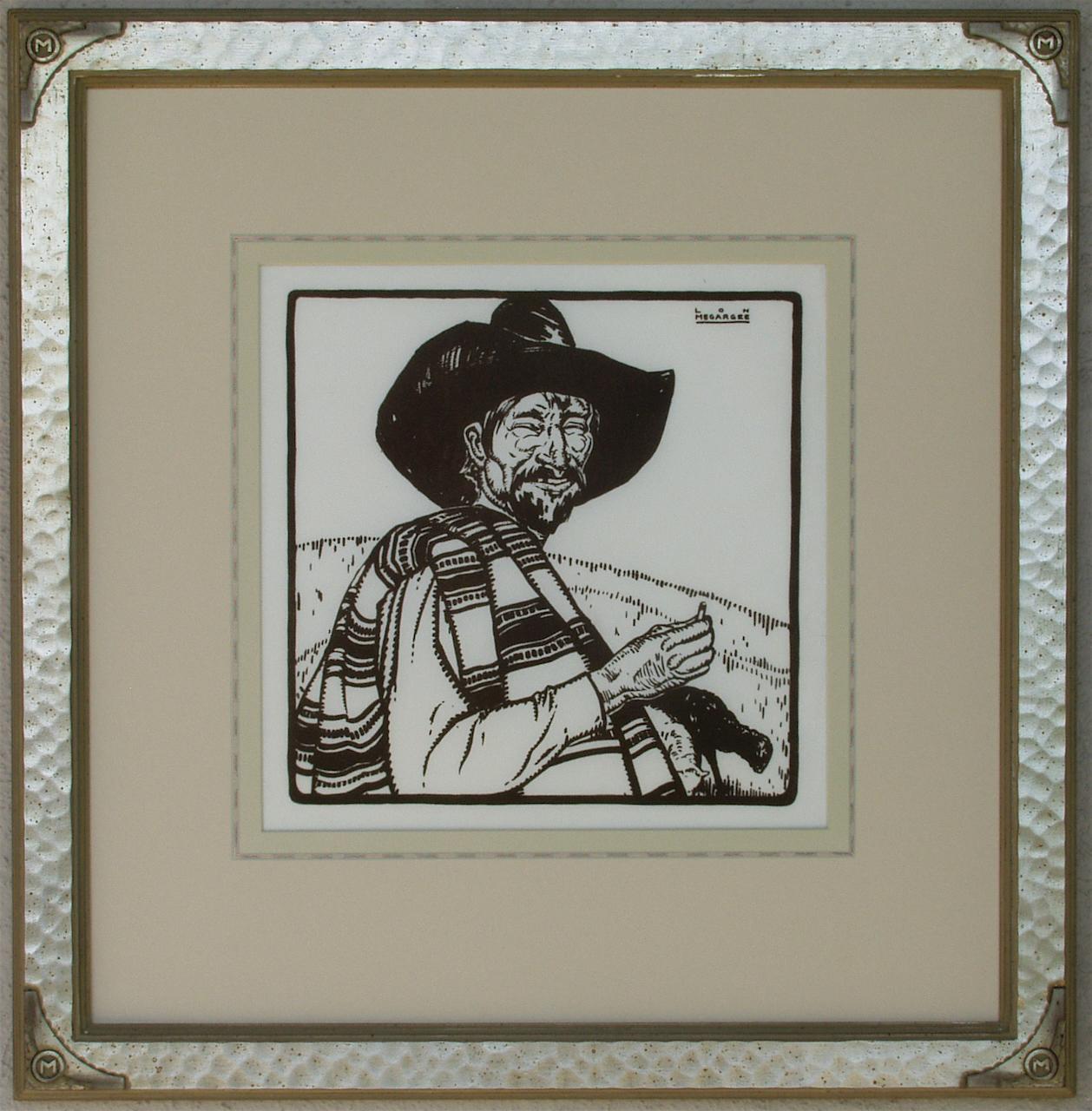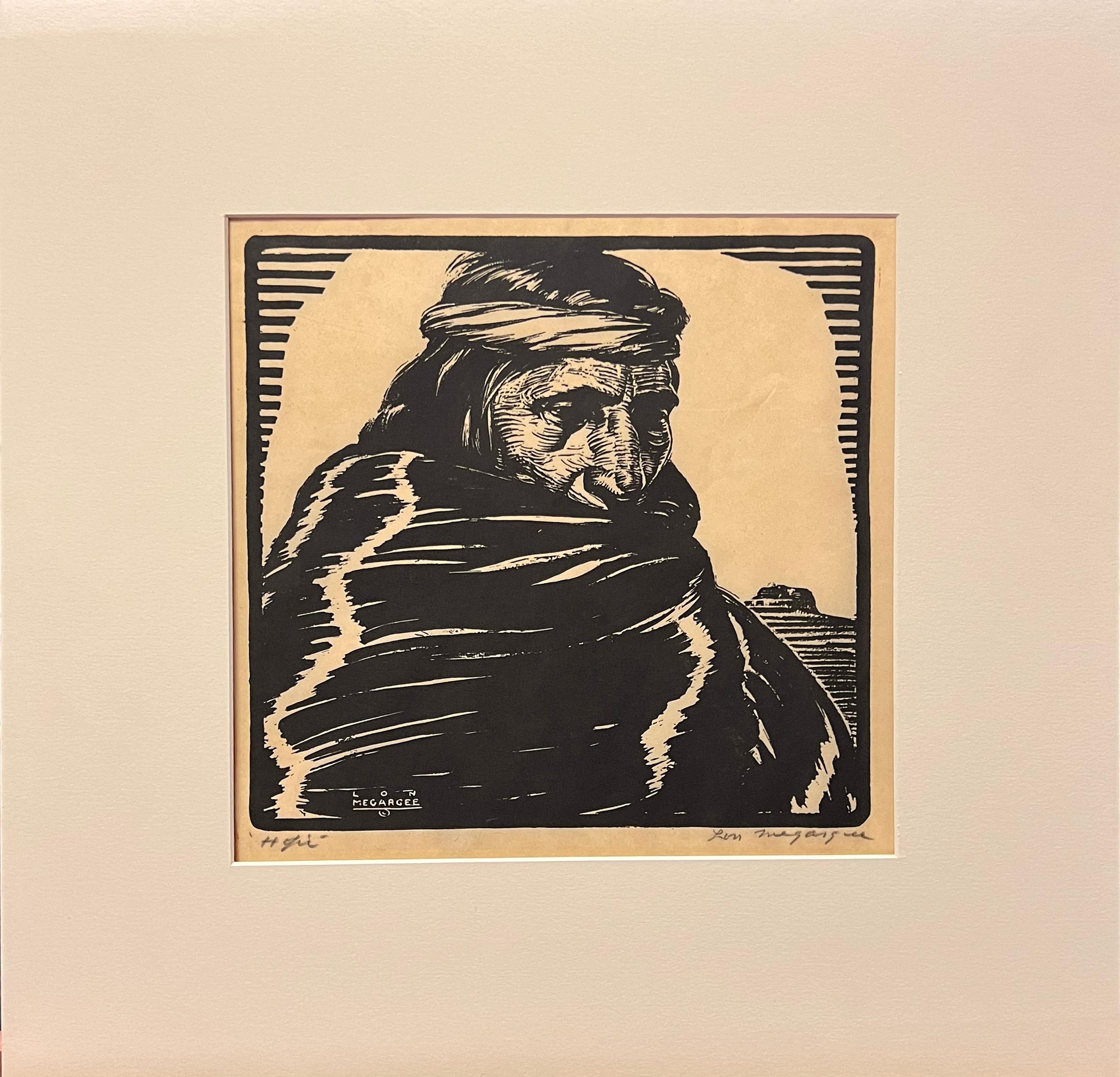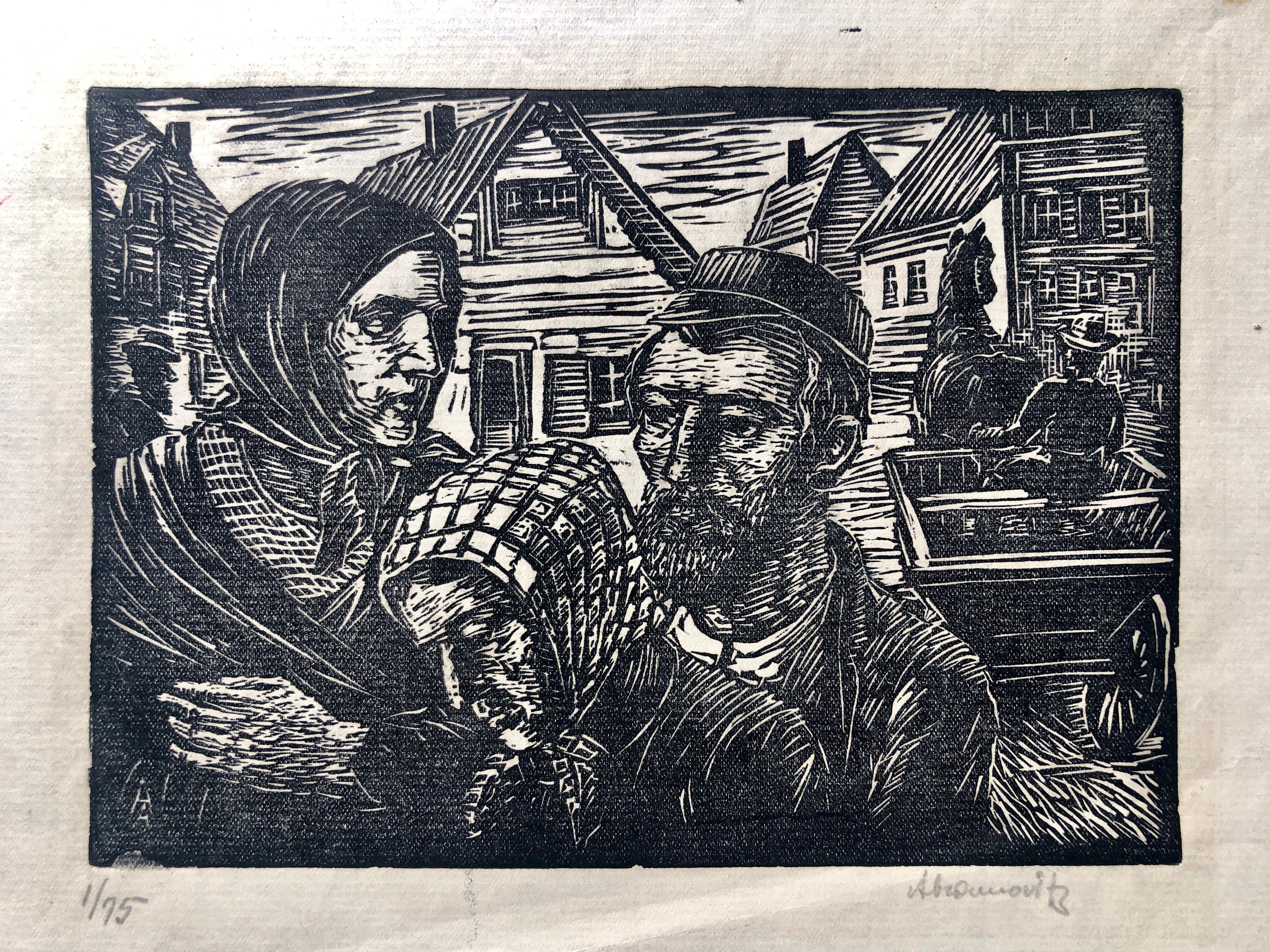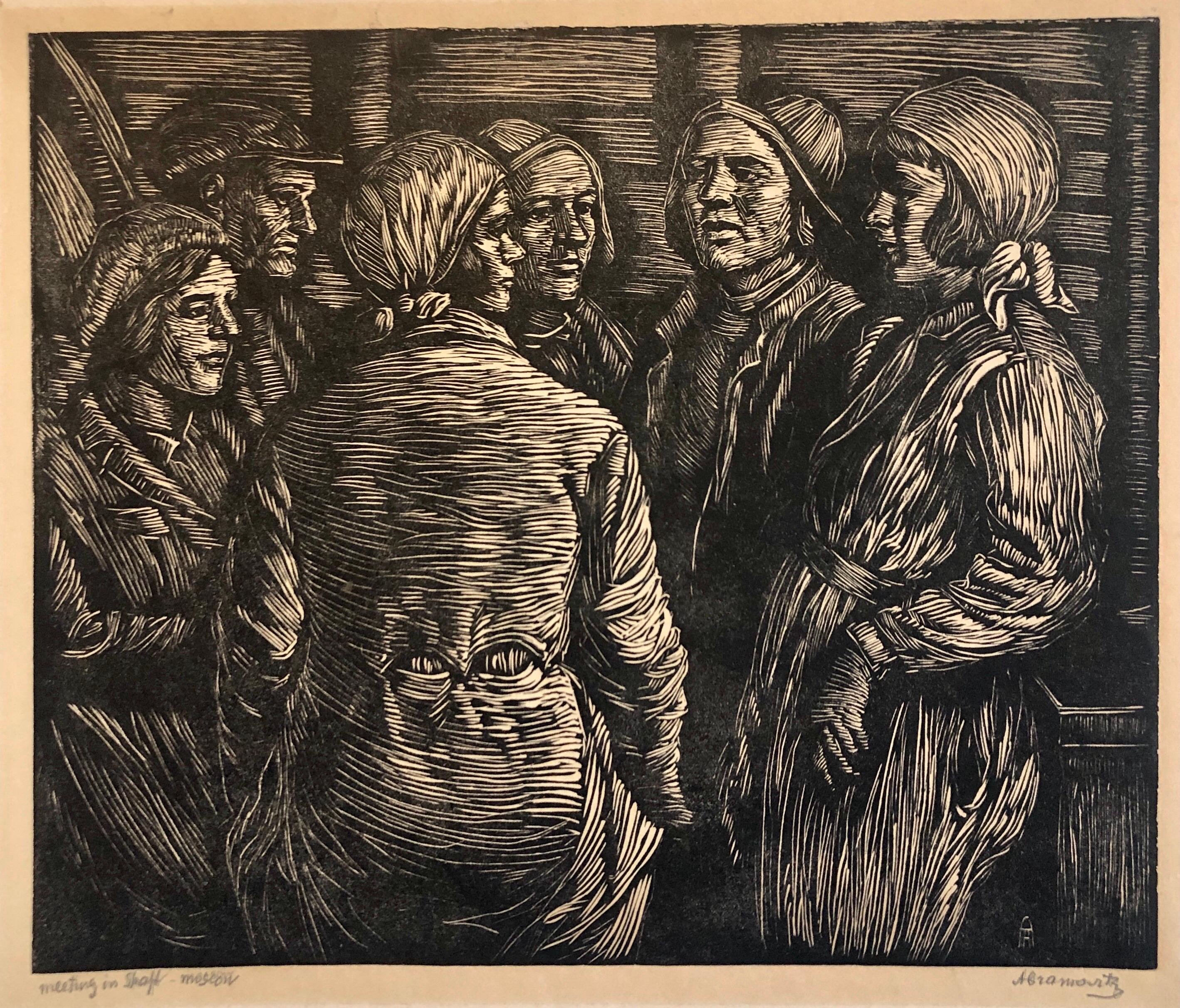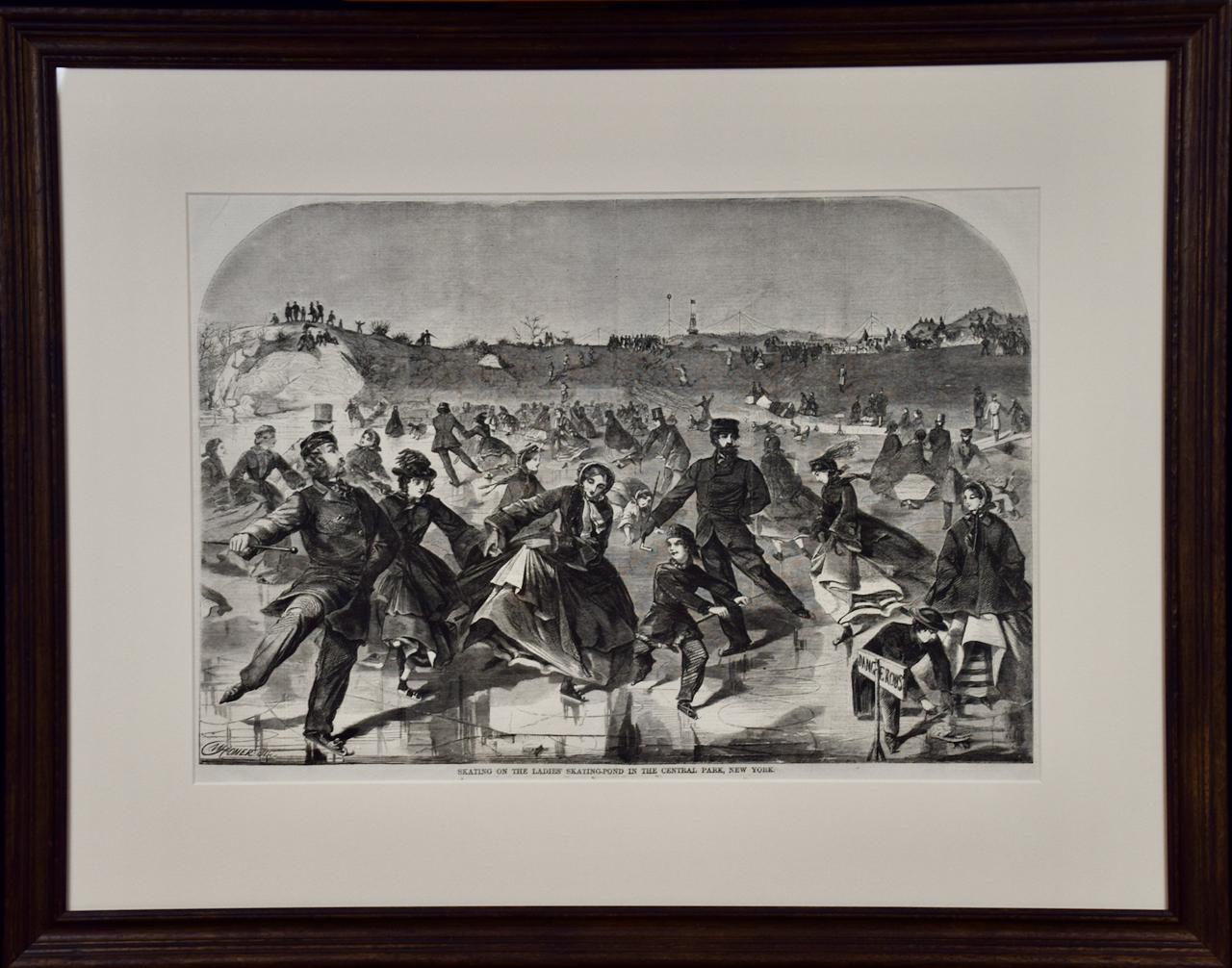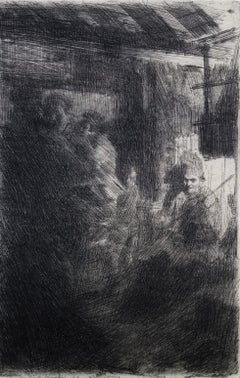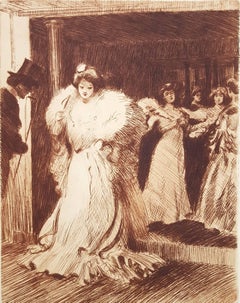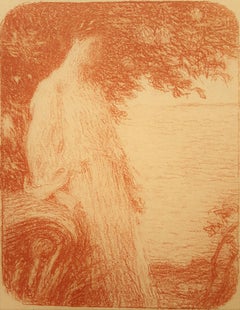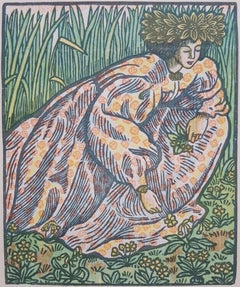
Quand Elle Va Sur L'herbe (Girl Picking Flowers)
View Similar Items
Want more images or videos?
Request additional images or videos from the seller
1 of 10
Lucien PissarroQuand Elle Va Sur L'herbe (Girl Picking Flowers)1919
1919
About the Item
- Creator:Lucien Pissarro (1863 - 1944, French)
- Creation Year:1919
- Dimensions:Height: 10.75 in (27.31 cm)Width: 6.75 in (17.15 cm)
- Medium:
- Movement & Style:
- Period:
- Condition:
- Gallery Location:Saint Augustine, FL
- Reference Number:1stDibs: LU12123181643
About the Seller
5.0
Platinum Seller
These expertly vetted sellers are 1stDibs' most experienced sellers and are rated highest by our customers.
Established in 1978
1stDibs seller since 2015
1,214 sales on 1stDibs
More From This SellerView All
- Dance at Gopsmor /// Impressionist Swedish Anders Zorn Etching Party AntiqueBy Anders ZornLocated in Saint Augustine, FLArtist: Anders Zorn (Swedish, 1860-1920) Title: "Dance at Gopsmor" *Signed by Zorn in pencil lower right. It is also signed and dated in the plate (printed signature) lower left Year: 1906 (second state of two) Medium: Original Etching on cream Van Gelder Zonen laid paper Limited edition: approx. 50 impressions Printer: the artist Zorn himself, Mora, Sweden Publisher: the artist Zorn himself, Mora, Sweden Reference: Asplund No. 197; Hjert & Hjert No. 205; Loys Delteil No. 192 Framing: Recently framed in a gold ornate moulding and fabric matting from Holland. All archival Framed size: 22.75" x 18.25" Sheet size (irregular margins): 16.5" x 11" Image size: 11.88" x 7.75" Condition: A strong impression in very good condition Very rare Notes: Provenance: private collection - Chicago, IL; acquired from Rothschild & Company, Chicago, IL in the early 1900's. Fleur-de-lis shield with text underneath (Van Gelder Zonen) watermark in center of sheet. "Towards the end of the nineteenth century and at the beginning of the twentieth century, Anders Zorn became increasingly interested in the history and ancient traditions of his native town Mora and its wider cultural territories which at the time, as a result of industrialisation and urbanisation, were begining to disappear. In 1904, Anders Zorn purchased an ancient farmhouse which he moved to the parish of Gopsmor, situated by the river Dal, North-West of Mora. The simple ritualistic lifestyle of its people, with whom he felt affinity, and Gopsmor's geographical isolation, became for Zorn, a place of refuge for the cosmopolitan artist". - Christie's, London, UK Biography: Anders Leonard Zorn...Category
Early 1900s Impressionist Figurative Prints
MaterialsLaid Paper, Etching, Intaglio
- L'Avant-Foyer de l'Opera /// French Impressionist Etching Figurative Lady ManBy Tony MinartzLocated in Saint Augustine, FLArtist: Tony Minartz (French, 1873-1944) Title: "L'Avant-Foyer de l'Opera" Portfolio: Revue de l'Art Ancien & Moderne *Issued unsigned Year: 1903 Medium: Original Etching on cream laid paper Limited edition: Unknown Printer: Unknown Publisher: Revue de l'Art Ancien & Moderne, Paris, France Framing: Not framed, but matted with 100% cotton rag matting from Holland, gold filet from Italy, and foam board backing. All archival Matted size: 17" x 14.5" Sheet size: 12" x 9" Image size: 9" x 7.25" Condition: In excellent condition Notes: Printed in one color: bistre. This review was founded in 1897 in the continuity of the review Les Beaux-Arts published between 1861 and 1865; Jules Comte, the founder, entitled his first issue Les Beaux-Arts - Revue nouvelle then changed the title to La Revue de l'art ancien et moderne. Jules Comte directed the review until his death in 1912. Raymond Woog took over , who was provisional director until the start of the war in July 1914. In 1919, André Dezarrois took over this review and was its director until December 1937, date of last issue (published in January 1938). In the meantime, it publishes the Bulletin of ancient and modern art, which has gained a certain notoriety in the community. Biography: Tony Minartz, pseudonym of Antoine Guillaume, born 8 April 1873 to Cannes and died in that city on 13 December 1944 Is a painter, draftsman , illustrator and engraver French. Painter autodidact , Tony Minartz starts to become known in 1896 by exhibiting paintings at the Salon of the National Society of Fine Arts , and then decorates the Pompadour theater of painted panels for fashion shows " Grand Guignol ", directed by L. Darthenay. In 1903, Henri Béraldi , with whom he worked, praised him in The Journal of ancient and modern art, writing that "it was thirty years ago," and he has received advice from Paul Renouard to be formed the technique of etching ; Béraldi adds that his favorite subjects are "Paris at night Paris at night, always." Minartz also gives them some high-remarkable in The Journal of ancient and modern art until 1910: balls, cafe concerts, Parisian in their most beautiful dresses, but also music-halls, music halls, restaurants, large and small theaters, are the preferred settings of his compositions. Its fertile period seems to end in 1914. In addition to the National Salon, Minartz exhibited in Paris at the gallery Bartholomew (1903), the Independent Living (1905, 1906) and the gallery Devambez (1909) and received the Academic Palms . He occasionally collaborates with periodic illustrated as The Almanac Sports (Ollendorff, 1899), or satirical as Gil Blas...Category
Early 1900s Impressionist Figurative Prints
MaterialsIntaglio, Laid Paper, Etching
- Sicile (Sicily) /// French Impressionist Lithograph Modern Figurative Lady ArtBy Ernest Joseph LaurentLocated in Saint Augustine, FLArtist: Ernest Joseph Laurent (French, 1859-1929) Title: "Sicile (Sicily)" Portfolio: Gazette Des Beaux-Arts *Issued unsigned, though monogram signed by Laurent in the plate (printed...Category
1910s Impressionist Figurative Prints
MaterialsLithograph
- Le Bouquet de Violettes (The Bouquet of Violets) /// Figurative ImpressionistBy Manuel RobbeLocated in Saint Augustine, FLArtist: Manuel Robbe (French, 1872-1936) Title: "Le Bouquet de Violettes (The Bouquet of Violets)" *Signed by Robbe in pencil lower right Year: 1903 Medium: Original Hand-Colored Etc...Category
Early 1900s Impressionist Figurative Prints
MaterialsEtching, Aquatint, Watercolor, Laid Paper, Intaglio
$1,600 Sale Price60% Off - Vision /// French Romantic Classical Figurative Lady Woman Soldier Angel LithoBy Henri Fantin-LatourLocated in Saint Augustine, FLArtist: Henri Fantin-Latour (French, 1836-1904) Title: "Vison" Portfolio: Gazette des Beaux-Arts *Issued unsigned Year: 1895 Medium: Original Lithograph on chine appliqué on wove paper Limited edition: approx. 1,500 Printer: Imprimeries Lemercier, Paris, France Publisher: Gazette des Beaux-Arts, Paris, France Reference: Hediard No. 122 (IV/IV); Sanchez & Seydoux 1895-6, page 126 Sheet size: 11" x 7.38" Image size: 7.5" x 5.75" Condition: Some minor discoloration in margins. In excellent condition Notes: Original cover tissue sleeve mounted at left margin as issued. This lithograph was published by Gazette des Beaux-Arts. The Gazette des Beaux-Arts was a French art review, found in 1859 by Édouard Houssaye, with Charles Blanc as its first chief editor. Assia Visson Rubinstein was chief editor under the direction of George Wildenstein from 1928 until 1960. Her papers, which include all editions of the Gazette from this period, are intact at the Cantonal and University Library of Lausanne in Dorigny. The Gazette was a world reference work on art history for nearly 100 years - one other editor in chief, from 1955 to 1987, was Jean Adhémar. It was bought in 1928 by the Wildenstein family, whose last representative was Daniel Wildenstein, its director from 1963 until his death in 2001. The review closed in 2002. Biography: Henri Fantin-Latour, in full Ignace-Henri-Jean-Théodore Fantin-Latour (born Jan. 14, 1836, Grenoble, France—died Aug. 25, 1904, Buré), French painter, printmaker, and illustrator noted for his still lifes with flowers and his portraits, especially group compositions, of contemporary French celebrities in the arts. Fantin-Latour’s first teacher was his father, a well-known portrait painter. Later, he studied at the school of Lecoq de Boisbaudran and attended the École des Beaux-Arts. He exhibited at the official French Salons, but in 1863 he also showed his work in the rebel Salon des Refusés. Although academic in manner, Fantin-Latour was independent in style. He had numerous friends among the leading French painters of his day, including J.-A.-D. Ingres, Eugène Delacroix, Camille Corot, Édouard Manet, and Gustave Courbet. His portrait groups, often arranged in rows of heads and figures like 17th-century Dutch guild portraits...Category
1890s Impressionist Figurative Prints
MaterialsLithograph
- Parisienne /// Art Nouveau French Lithograph Impressionist Figurative Lady WomanBy Maurice EliotLocated in Saint Augustine, FLArtist: Maurice Eliot (French, 1862-1945) Title: "Parisienne" Portfolio: Revue de l'Art Ancien & Moderne *Issued unsigned, though signed by Eliot in the plate (printed signature) low...Category
Early 1900s Impressionist Figurative Prints
MaterialsLithograph
You May Also Like
- The Sheepherder by Lon MegargeeLocated in Phoenix, AZLon Megargee 1883-1960 "The Sheepherder" Wood block print Signed in plate, lower right Image size: 10 x 10 inches Frame size 22 x 22 inches Creator of Stetson's hat logo "Last Drop from his Hat" Lon Megargee 1883 - 1960 At age 13, Lon Megargee came to Phoenix in 1896 following the death of his father in Philadelphia. For several years he resided with relatives while working at an uncle’s dairy farm and at odd jobs. He returned to Philadelphia in 1898 – 1899 in order to attend drawing classes at the Pennsylvania Academy of the Fine Arts. Back in Phoenix in 1899, he decided at the age of 16 to try to make his living as a cowboy. Lon moved to the cow country of Wickenburg, Arizona where he was hired by Tex Singleton’s Bull Ranch. He later joined the Three Bar R. . . and after a few years, was offered a job by Billy Cook of the T.T. Ranch near New River. By 1906, Megargee had learned his trade well enough to be made foreman of Cook’s outfit. Never shy about taking risks, Lon soon left Cook to try his own hand at ranching. He partnered with a cowpuncher buddy, Tom Cavness, to start the El Rancho Cinco Uno at New River. Unfortunately, the young partners could not foresee a three-year drought that would parch Arizona, costing them their stock and then their hard-earned ranch. Breaking with his romantic vision of cowboy life, Megargee finally turned to art full time. He again enrolled at the Pennsylvania Academy of Art and then the Los Angeles School of Art and Design during 1909 – 1910. The now well-trained student took his first trip to paint “en plein air” (outdoors) to the land of Hopi and Navajo peoples in northern Arizona. After entering paintings from this trip in the annual Territorial Fair at Phoenix, in 1911, he surprisingly sold his first oil painting to a major enterprise – the Santa Fe Railroad . . . Lon received $50 for “Navajos Watching the Santa Fe Train.” He soon sold the SFRR ten paintings over the next two years. For forty years the railroad was his most important client, purchasing its last painting from him in 1953. In a major stroke of good fortune during his early plein-air period, Megargee had the opportunity to paint with premier artist, William R. Leigh (1866 – 1955). Leigh furnished needed tutoring and counseling, and his bright, impressionistic palette served to enhance the junior artist’s sense of color and paint application. In a remarkable display of unabashed confidence and personable salesmanship, Lon Megargee, at age 30, forever linked his name with Arizona art history. Despite the possibility of competition from better known and more senior artists, he persuaded Governor George Hunt and the Legislature in 1913 to approve 15 large, historic and iconic murals for the State Capitol Building in Phoenix. After completing the murals in 1914, he was paid the then princely sum of roughly $4000. His Arizona statehood commission would launch Lon to considerable prominence at a very early point in his art career. Following a few years of art schooling in Los Angeles, and several stints as an art director with movie studios, including Paramount, Megargee turned in part to cover illustrations for popular Western story magazines in the 1920s. In the 1920s, as well, Lon began making black and white prints of Western types and of genre scenes from woodblocks. These prints he generally signed and sold singly. In 1933, he published a limited edition, signed and hard-cover book (about 250 copies and today rare)containing a group of 28 woodblock images. Titled “The Cowboy Builds a Loop,” the prints are noteworthy for strong design, excellent draftsmanship, humanistic and narrative content, and quality. Subjects include Southwest Indians and cowboys, Hispanic men and women, cattle, horses, burros, pioneers, trappers, sheepherders, horse traders, squaw men and ranch polo players. Megargee had a very advanced design sense for simplicity and boldness which he demonstrated in how he used line and form. His strengths included outstanding gestural (action) art and strong figurative work. He was superb in design, originality and drawing, as a study of his prints in the Hays collection reveals. In 1944, he published a second group of Western prints under the same title as the first. Reduced to 16 images from the original 28 subjects, and slightly smaller, Lon produced these prints in brown ink on a heavy, cream-colored stock. He designed a sturdy cardboard folio to hold each set. For the remainder of his life, Lon had success selling these portfolios to museum stores, art fairs and shows, and to the few galleries then selling Western art. Drawing on real working and life experiences, Lon Megargee had a comprehensive knowledge, understanding and sensitivity for Southwestern subject matter. Noted American modernist, Lew Davis...Category
Early 20th Century American Impressionist Figurative Prints
MaterialsWoodcut
- Hopi by Lon Megargee, Original Signed Block Print ca. 1920sLocated in Phoenix, AZTitle: Hopi ca. 1920s Artist: Lon Megargee Medium: Block Print Size: 11 x 11 inches (Sight Measurement) Creator of Stetson's hat logo "Last Drop from his Hat" Image of Lon Megargee not included in purchase. Lon Megargee 1883 - 1960 At age 13, Lon Megargee came to Phoenix in 1896 following the death of his father in Philadelphia. For several years he resided with relatives while working at an uncle’s dairy farm and at odd jobs. He returned to Philadelphia in 1898 – 1899 in order to attend drawing classes at the Pennsylvania Academy of the Fine Arts. Back in Phoenix in 1899, he decided at the age of 16 to try to make his living as a cowboy. Lon moved to the cow country of Wickenburg, Arizona where he was hired by Tex Singleton’s Bull Ranch. He later joined the Three Bar R. . . and after a few years, was offered a job by Billy Cook of the T.T. Ranch near New River. By 1906, Megargee had learned his trade well enough to be made foreman of Cook’s outfit. Never shy about taking risks, Lon soon left Cook to try his own hand at ranching. He partnered with a cowpuncher buddy, Tom Cavness, to start the El Rancho Cinco Uno at New River. Unfortunately, the young partners could not foresee a three-year drought that would parch Arizona, costing them their stock and then their hard-earned ranch. Breaking with his romantic vision of cowboy life, Megargee finally turned to art full time. He again enrolled at the Pennsylvania Academy of Art and then the Los Angeles School of Art and Design during 1909 – 1910. The now well-trained student took his first trip to paint “en plein air” (outdoors) to the land of Hopi and Navajo peoples in northern Arizona. After entering paintings from this trip in the annual Territorial Fair at Phoenix, in 1911, he surprisingly sold his first oil painting to a major enterprise – the Santa Fe Railroad . . . Lon received $50 for “Navajos Watching the Santa Fe Train.” He soon sold the SFRR ten paintings over the next two years. For forty years the railroad was his most important client, purchasing its last painting from him in 1953. In a major stroke of good fortune during his early plein-air period, Megargee had the opportunity to paint with premier artist, William R. Leigh (1866 – 1955). Leigh furnished needed tutoring and counseling, and his bright, impressionistic palette served to enhance the junior artist’s sense of color and paint application. In a remarkable display of unabashed confidence and personable salesmanship, Lon Megargee, at age 30, forever linked his name with Arizona art history. Despite the possibility of competition from better known and more senior artists, he persuaded Governor George Hunt and the Legislature in 1913 to approve 15 large, historic and iconic murals for the State Capitol Building in Phoenix. After completing the murals in 1914, he was paid the then princely sum of roughly $4000. His Arizona statehood commission would launch Lon to considerable prominence at a very early point in his art career. Following a few years of art schooling in Los Angeles, and several stints as an art director with movie studios, including Paramount, Megargee turned in part to cover illustrations for popular Western story magazines in the 1920s. In the 1920s, as well, Lon began making black and white prints of Western types and of genre scenes from woodblocks. These prints he generally signed and sold singly. In 1933, he published a limited edition, signed and hard-cover book (about 250 copies and today rare)containing a group of 28 woodblock images. Titled “The Cowboy Builds a Loop,” the prints are noteworthy for strong design, excellent draftsmanship, humanistic and narrative content, and quality. Subjects include Southwest Indians and cowboys, Hispanic men and women, cattle, horses, burros, pioneers, trappers, sheepherders, horse traders, squaw men and ranch polo players. Megargee had a very advanced design sense for simplicity and boldness which he demonstrated in how he used line and form. His strengths included outstanding gestural (action) art and strong figurative work. He was superb in design, originality and drawing, as a study of his prints in the Hays collection reveals. In 1944, he published a second group of Western prints under the same title as the first. Reduced to 16 images from the original 28 subjects, and slightly smaller, Lon produced these prints in brown ink on a heavy, cream-colored stock. He designed a sturdy cardboard folio to hold each set. For the remainder of his life, Lon had success selling these portfolios to museum stores, art fairs and shows, and to the few galleries then selling Western art. Drawing on real working and life experiences, Lon Megargee had a comprehensive knowledge, understanding and sensitivity for Southwestern subject matter. Noted American modernist, Lew Davis...Category
1920s American Impressionist Figurative Prints
MaterialsWoodcut
- The War Bonnet by Lon MegargeeLocated in Phoenix, AZLon Megargee 1883-1960 "The War Bonnet" Wood block print Signed: original pencil signature, lower right Image size: 11 x 11 inches Frame size 22 x 22 inches Creator of Stetson's hat logo "Last Drop from his Hat" Lon Megargee 1883 - 1960 At age 13, Lon Megargee came to Phoenix in 1896 following the death of his father in Philadelphia. For several years he resided with relatives while working at an uncle’s dairy farm and at odd jobs. He returned to Philadelphia in 1898 – 1899 in order to attend drawing classes at the Pennsylvania Academy of the Fine Arts. Back in Phoenix in 1899, he decided at the age of 16 to try to make his living as a cowboy. Lon moved to the cow country of Wickenburg, Arizona where he was hired by Tex Singleton’s Bull Ranch. He later joined the Three Bar R. . . and after a few years, was offered a job by Billy Cook of the T.T. Ranch near New River. By 1906, Megargee had learned his trade well enough to be made foreman of Cook’s outfit. Never shy about taking risks, Lon soon left Cook to try his own hand at ranching. He partnered with a cowpuncher buddy, Tom Cavness, to start the El Rancho Cinco Uno at New River. Unfortunately, the young partners could not foresee a three-year drought that would parch Arizona, costing them their stock and then their hard-earned ranch. Breaking with his romantic vision of cowboy life, Megargee finally turned to art full time. He again enrolled at the Pennsylvania Academy of Art and then the Los Angeles School of Art and Design during 1909 – 1910. The now well-trained student took his first trip to paint “en plein air” (outdoors) to the land of Hopi and Navajo peoples in northern Arizona. After entering paintings from this trip in the annual Territorial Fair at Phoenix, in 1911, he surprisingly sold his first oil painting to a major enterprise – the Santa Fe Railroad . . . Lon received $50 for “Navajos Watching the Santa Fe Train.” He soon sold the SFRR ten paintings over the next two years. For forty years the railroad was his most important client, purchasing its last painting from him in 1953. In a major stroke of good fortune during his early plein-air period, Megargee had the opportunity to paint with premier artist, William R. Leigh (1866 – 1955). Leigh furnished needed tutoring and counseling, and his bright, impressionistic palette served to enhance the junior artist’s sense of color and paint application. In a remarkable display of unabashed confidence and personable salesmanship, Lon Megargee, at age 30, forever linked his name with Arizona art history. Despite the possibility of competition from better known and more senior artists, he persuaded Governor George Hunt and the Legislature in 1913 to approve 15 large, historic and iconic murals for the State Capitol Building in Phoenix. After completing the murals in 1914, he was paid the then princely sum of roughly $4000. His Arizona statehood commission would launch Lon to considerable prominence at a very early point in his art career. Following a few years of art schooling in Los Angeles, and several stints as an art director with movie studios, including Paramount, Megargee turned in part to cover illustrations for popular Western story magazines in the 1920s. In the 1920s, as well, Lon began making black and white prints of Western types and of genre scenes from woodblocks. These prints he generally signed and sold singly. In 1933, he published a limited edition, signed and hard-cover book (about 250 copies and today rare)containing a group of 28 woodblock images. Titled “The Cowboy Builds a Loop,” the prints are noteworthy for strong design, excellent draftsmanship, humanistic and narrative content, and quality. Subjects include Southwest Indians and cowboys, Hispanic men and women, cattle, horses, burros, pioneers, trappers, sheepherders, horse traders, squaw men and ranch polo players. Megargee had a very advanced design sense for simplicity and boldness which he demonstrated in how he used line and form. His strengths included outstanding gestural (action) art and strong figurative work. He was superb in design, originality and drawing, as a study of his prints in the Hays collection reveals. In 1944, he published a second group of Western prints under the same title as the first. Reduced to 16 images from the original 28 subjects, and slightly smaller, Lon produced these prints in brown ink on a heavy, cream-colored stock. He designed a sturdy cardboard folio to hold each set. For the remainder of his life, Lon had success selling these portfolios to museum stores, art fairs and shows, and to the few galleries then selling Western art. Drawing on real working and life experiences, Lon Megargee had a comprehensive knowledge, understanding and sensitivity for Southwestern subject matter. Noted American modernist, Lew...Category
Early 20th Century American Impressionist Figurative Prints
MaterialsWoodcut
- Jewish Wedding Judaica Woodblock Print c.1930s WPA Woodcut Print Hand SignedBy Albert AbramovitzLocated in Surfside, FLSome of his prints were published by the WPA. it is a wood engraving signed in pencil. From a small edition. Albert Abramovitz (1879-1963), bor...Category
1930s American Impressionist Figurative Prints
MaterialsWoodcut
- Jewish Shtetl Couple Judaica Woodblock c.1930s WPA Woodcut Print Hand SignedBy Albert AbramovitzLocated in Surfside, FLSome of his prints were published by the WPA. it is a wood engraving signed in pencil. From a small edition. Albert Abramovitz (1879-1963), born in Riga, Latvia, on January 24, 187...Category
1930s American Impressionist Figurative Prints
MaterialsWoodcut
- Coming Home Woodblock Print c.1930's WPA Woodcut Print Hand SignedBy Albert AbramovitzLocated in Surfside, FLSome of his prints were published by the WPA some were done in Soviet Moscow in Russia.. it is a wood engraving signed in pencil. From a small edition. Albert Abramovitz (1879-1963...Category
1930s American Impressionist Figurative Prints
MaterialsWoodcut
Recently Viewed
View AllMore Ways To Browse
Editors Picks
A Herbe
Picasso Original Art For Sale
Figurative Ancient Rome
Lithograph France Flowers
Chanel Coco First
Vintage Pop Art Posters
Villa Roman
Georges Braque Cubism
Schiele Egon
Large Stained Glass Window
Prison Vintage
Alfred Hitchcock
Dali Divine Woodcut
Dali Set
Picasso Print 1955
Vintage Wedding Painting
Lichtenstein Style
